October 2016 ESE Newsletter
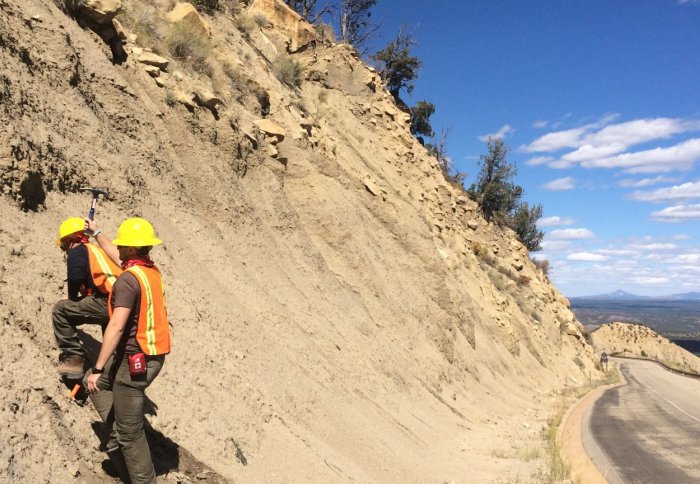
Geoscientists conduct fieldwork in Colorado
A new academic year: new students join ESE, geoscientists in the US, multi-ring Craters and more
Contents
Publications
Conferences, Lectures and Seminars
Departmental Activities
Awards
Research Grants
Research Activity
Impact and Media
Fieldwork
PhD vivas
New Staff
Publications
Albalushi, A., Neumaier, M., Fraser, A.J., & Jackson, C.A-L. (2016). The impact of the Messinian Salinity Crisis on the petroleum system of the Eastern Mediterranean: a critical assessment using 2D-petroleum system modelling. Petroleum Geoscience, 357-379. doi:10.1144/petgeo2016-054
Allen, H., Jackson, CA-L., & Fraser, A.J. (2016). Gravity-driven deformation of a youthful saline giant: the interplay between gliding and spreading in the Messinian Basins of the Eastern Mediterranean. Petroleum Geoscience, 340-356. doi:10.1144/petgeo2016-034
Burberry, C.M., Jackson, C.A-L., & Chandler, S.R. (2016). Seismic reflection imaging of karst in the Persian Gulf: Implications for the characterization of carbonate reservoirs. AAPG Bulletin, 1561-1584. doi:10.1306/04151615115
Cooper, S.J., Bertei, A., Shearing, P.R., Kilner, J.A., & Brandon, N.P. (2016). TauFactor: An open-source application for calculating tortuosity factors from tomographic data. SoftwareX, http://dx.doi.org/10.1016/j.softx.2016.09.002
Døssing, A., Muxworthy, A.R., Supakulopas, R., Riishuus, M.S., and Mac Niocaill, C. (2016). High northern geomagnetic field behavior and new constraints on the Gilsá event: Paleomagnetic and 40Ar/39Ar results of ∼0.5–3.1 Ma basalts from Jökuldalur, Iceland. Earth Planetary Science Letters, doi:10.1016/j.epsl.2016.09.022.
van de Flierdt, T., Griffiths, A.M., Lambelet, M., Little, S.H., Stichel, T. & Wilson, D.J. (2016). Neodymium in the Oceans: A global database, a regional comparison, and implications for palaeoceanographic research. Philosophical Transactions of the Royal Society A, 374: 20150293. http://dx.doi.org/10.1098/rsta.2015.0293.
Green, D.N., I.D. Bastow, B. Dashwood, and S.E.J. Nippress, Characterizing Broadband Seismic Noise in Central London, Seis. Res. Letts., 88(1), doi:10.1785/0220160128, 2017.
Johnson, B.C., Blair, D.M., Collins, G.S., Melosh, H.J., Freed, A.M., Taylor, G.J., Head, J.W., Wieczorek, M.A., Andrews-Hanna, J.C., Nimmo, F., Keane, J.T., Miljkovi?, K., Soderblom, J.M., Zuber, M.T., 2016. Formation of the Orientale lunar multiring basin. Science 354, 441–444. doi:10.1126/science.aag0518
Kring, D.A., Kramer, G.Y., Collins, G.S., Potter, R.W.K., Chandnani, M., 2016. Peak-ring structure and kinematics from a multi-disciplinary study of the Schrödinger impact basin. Nature Communications 7, 13161. doi:10.1038/ncomms13161
McPhee, B. W., Upchurch, P., Mannion, P. D., Sullivan, C., Butler, R. J. and Barrett, P. M. 2016. A revision of Sanpasaurus yaoi Young, 1944 from the Early Jurassic of China, and its relevance to the early evolution of Sauropoda (Dinosauria).PeerJ, 4: e2578. doi: 10.7717/peerj.2578.
Poropat, S. F., Mannion, P. D., Upchurch, P., Hocknull, S. A., Kear, B. P., Kundrát, M., Tischler, T. T., Sloan, T., Sinapius, G. H. K., Elliott, J. A. and Elliott, D. A. (2016). New Australian sauropods shed light on Cretaceous dinosaur palaeobiogeography.Scientific Reports, 6: 34467. doi: 10.1038/srep34467 (first 3 authors listed as joint lead authors).
Prytulak, J. (2016). Protactinium. Encyclopedia of Geochemistry, ed. W.M. White. Springer Publishing. doi: 10.1007/978-3-319-39193-9_273-1.
Prytulak, J., Sossi, P.A., Halliday, A.N., Plank, T., Savage, P.S., Woodhead, J. (2017). Stable vanadium isotopes as a redox proxy in magmatic systems? Geochemical Perspectives Letters, 3, 75-84. Open Access Link: http://www.geochemicalperspectivesletters.org/article1708
Conferences, Lectures and Seminars
October has been a busy month of conferences and talks from ESE geoscientists. Chris Jackson visited the Natural History Museum to give a talk to the London Branch of the Open University Geological Society on 20 October. Chris’ talk was entitled “The rock that wouldn’t stay still; a brief introduction to evaporites”.
Chris later returned to his alma mater, the University of Manchester on 27 October, to give a talk to the AAPG Student Chapter. His talk was entitled “The internal structure and composition of salt diapirs: What do we know, what might we want to know and why might it be important?”.
Nigel Brandon was invited as a keynote to an event on 15 October exploring natural gas’s role in the global energy transition – “Can long-term growth for natural gas be sustained?". The event was organised by the British Institute of Energy Economics and took place at the Shell Centre.
In September, the Sustainable Gas Institute (SGI) and Research Centre for Gas Innovation (RCGI) hosted the first annual conference in natural gas sustainability in São Paulo, Brazil. Sustainable Gas Research Innovation 2016 took place on the 27 and 28 September. Nigel Brandon and Kris Anderson spoke at the event. Dr Julia Sachs, a Research Associate at the conference wrote a summary blog about the event. Next year's meeting will take place on September 19 and 20 in São Paulo, Brazil.
This year the Sustainable Gas Institute's Annual Lecture will be given by David Parkin, Director of Safety and Network Strategy at National Grid. The Annual lecture, entitled “Renewable Gas: The lowest cost pathway to decarbonising heat?” will take place on Tuesday 6 December in Room 1.31, RSM and will be followed by a drinks reception.
PhD student Oscar Agudo spoke at the SEG 2016 conference in Dallas presenting a talk entitled ‘Acoustic full-waveform inversion in an elastic world’.
Adrian Muxworthy gave an invited talk at the FORC conference in New Orleans and a departmental seminar at the University of Rochester.
Phil Mannion and Jon Tennant both attended the annual meeting of the Society of Vertebrate Paleontology, held in Salt Lake City, Utah (26-29 October). Phil Mannion was the co-author of several presentations on sauropod dinosaur evolution. Jon Tennant gave a talk in the prestigious Romer Prize session, where the best student research is brought together. Jon presented some of the main results from his recently completed thesis on diversity patterns across the Jurassic/Cretaceous boundary.
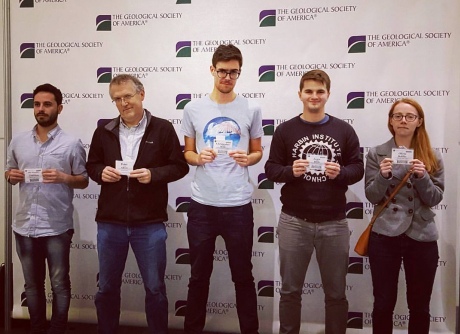
Earth Scientists at GSA: (from Left) Alessandro Chiarenza, Peter Allison, Chris Dean, Lewis Jones and Olivia Bentley
The department had a strong presence at the annual meeting of the GSA in late September (25-28). PhD students Olivia Bentley, Alessandro Chiarenza, Chris Dean and Lewis Jones attended with Peter Allison.
Olivia presented “The role of Bathymetry in Upwelling Induced Productivity in icehouse and greenhouse worlds”, Olivia Bentley, Peter Allison, Alexandros Avdis and Matthew Piggott.
Alessandro presented “Cretaceous Dinosaur-bearing formations: Prediction and implications for fossil bias estimation”, Alessandro Chiarenza, Peter Allison, Philip Mannion, Dan Lunt and Paul Markwick.
Finally, Chris presented “Spatial aragonite bias in epicontinental seas”, Christopher Dean, Peter Allison, Gary Hampson, Dan Lunt, Alexandros Avdis, and Paul Markwick.
Departmental Activities
This month the department welcomes its new intake of undergraduate and postgraduate students.
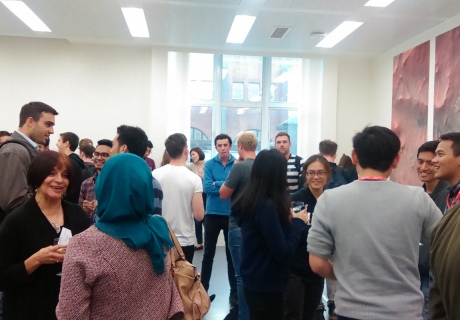
In early October the new MSc students were invited to attend a welcome session with key academic, teaching and support staff in addition to alumni. New PhD students were also welcomed to ESE by the Head of the Department, Mark Sephton.
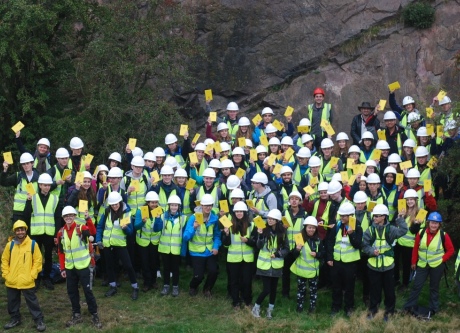
First year undergraduates visit Charnwood, Leicestershire for their first fieldtrip
The department’s new undergraduates had their first experience of geological fieldwork early this month at Charnwood, Leicestershire joined by staff, PhD students and the new departmental drone!
The department is also pleased to announce that new fieldwork posters have been created showing off our great fieldwork.They can be found on the ground floor corridor.
Awards
October 19 was a day to remember for Earth Science and Engineering – Commemoration Day. Hundreds of ESE students (class of 2016), their families and friends were welcomed by a fanfare at the Royal Albert Hall. During the ceremony Martin Blunt was awarded the prestigious President’s medal for outstanding contributions to teaching excellence.
PhD student Martin Mangler won an award to attned the ‘Cities on Volcanoes ’ conference in Puerto Varas, Chile (20-25 November) as an Early Career Science Ambassador of the European Association of Geochemistry (EAG). With the award Martin will attend the volcanologist’s conference, at which he will present results of his research on Popocatépetl volcano (Mexico), and give a talk about his working group’s outreach in schools around the volcano.
Samuel Cooper and colleagues from the department of Materials: Matthew Niania, John Kilner, and colleagues from Kyushu University, Japan: Helena Tellez, John Druce & Tatsumi Ishihara received the Adrian Daiwa award for outstanding scientific contribution resulting from collaboration with Japan.
Research Grants
Ian Bastow secured a £1000 grant from the Royal Astronomical Society to support an early career researcher to take part in a collaborative project in Bergen, Norway in 2017. Ian also secured a Royal Society International Exchanges grant of £11,982 for a collaborative project with Stephane Rondenay, Bergen - “Using seismology to better-understand the Moho: a global receiver function study".
Helen Lacey, a PhD student in the ESE Rock Mechanics Group, and former ESE researcher Veerle Vandeginste, now at the University of Nottingham, were awarded £10,500 from the Engineering and Physical Sciences Partnered Access Fund at the University of Nottingham. The funds will be used to help undertake microstructural analysis of experimental fault zones, and to strengthen Helen and Veerle’s research collaboration with the China Earthquake Administration in Beijing.
Research Activity
This month, Adrian Muxworthy spent a week at the University of Alberta working with Professor Ted Evans on rapid geomagnetic field reversals.
Impact and Media
Gareth Collins co-authored a paper that made the cover of Science this month using computer modelling to reveal the origin of the multi-ring lunar crater – Orientale. This research is also covered on the Imperial College website.
Phil Mannion's paper in Scientific Reports describing new Australian sauropod dinosaurs, received a large amount of media coverage, including the BBC, Guardian, National Geographic and the Daily Mail.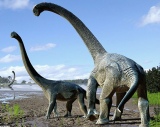
Dick Selley was interviewed by the BBC speaking on the Horse Hill, AKA the 'Gatwick Gusher' - an oil discovery in the Weald.
Fieldwork
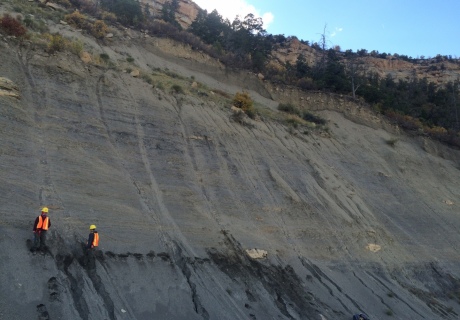
PhD students Christopher Dean, Alessandro Chiarenza and Lewis Jones spent 2 weeks in the Mid-west USA conducting fieldwork. They were looking at the Western Interior Seaway during the Cenomanian/Turonian Boundary and Lower-Campanian. Here they studied the impact of varying facies on the distribution and preservation of biota. They stopped at sites in Colorado and New Mexico testing how the preservation of aragonitic fauna might have varied spatially due to early stage dissolution.
PhD vivas
The department celebrates the success of several PhD students that passed their vivas this month:
Jon Tennant passed his viva on 5 October. Jon’s thesis is entitled ‘The Jurassic/ Cretaceous boundary: a hidden mass extinction in tertrapods?’
Katy Murphy passed her PhD viva on 12 October. Her thesis is entitled: ‘Isotopic Studies in Marine Geochemistry’. Congratulations from the proud supervisors, Mark Rehkamper and Tina van de Flierdt and the MAGIC group.
Julia Beckert successfully defended her PhD on October 31st, proving Halloween to be an auspicious day! Julia started her PhD within the carbonate group, and was supervised by Cédric John and Veerle Vandeginste (University of Nottingham). Julia worked on fracture-related dolomite bodies in the Oman Mountains, where she demonstrated that karstification played a potentially important role in controlling the shape and distribution of the dolomite bodies.
New Staff
The department welcomes Pamela Tempone, who joined the ESE Rock Mechanics Group this month as a PDRA. She will be working with Adriana Paluszny and Robert Zimmerman on the EPSRC-funded CONTAIN carbon sequestration project. Pamela most recently worked as a geomechanics researcher for BP Reservoir Development.
Article text (excluding photos or graphics) © Imperial College London.
Photos and graphics subject to third party copyright used with permission or © Imperial College London.
Reporter
Press Office
Communications and Public Affairs
- Email: press.office@imperial.ac.uk
